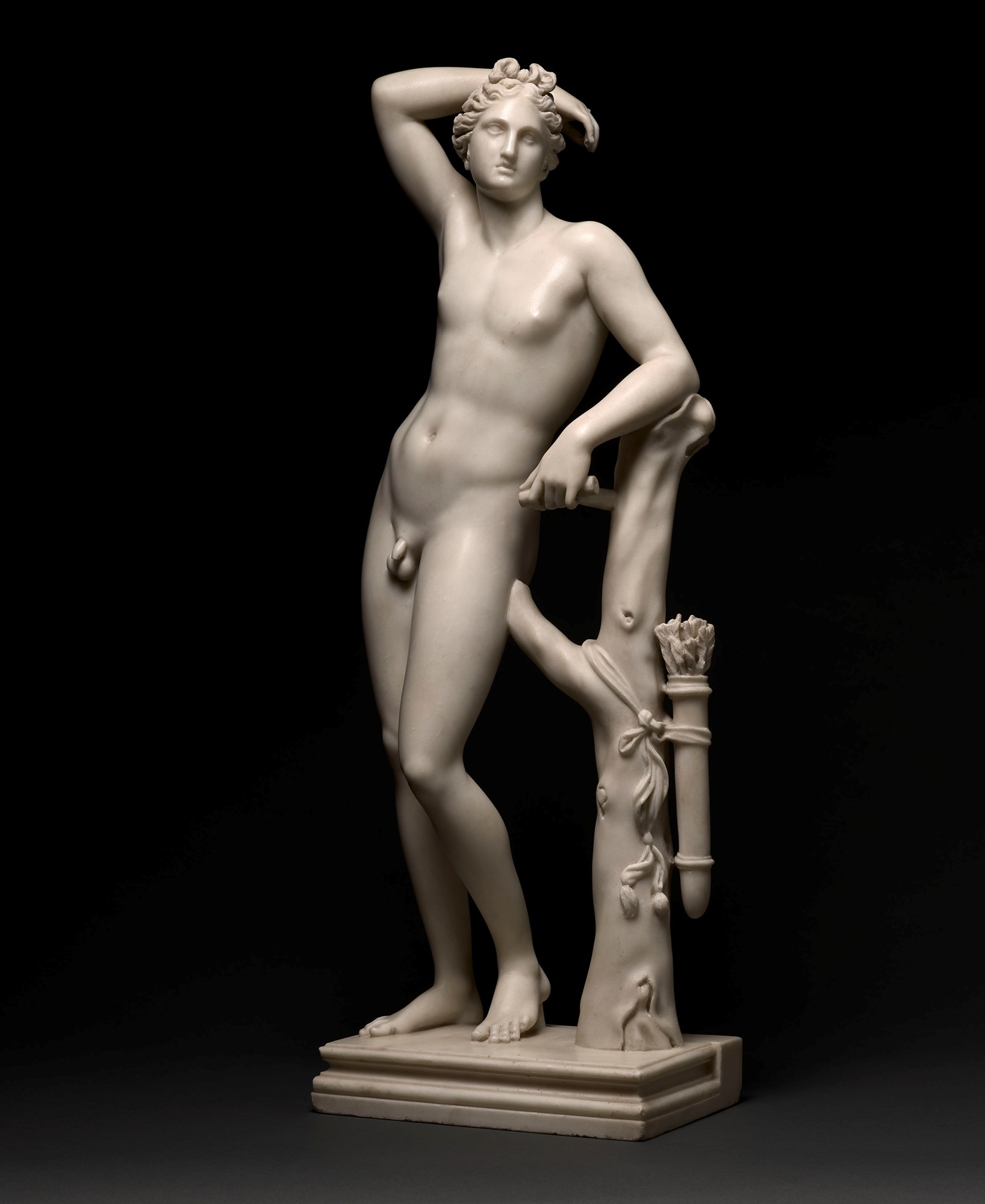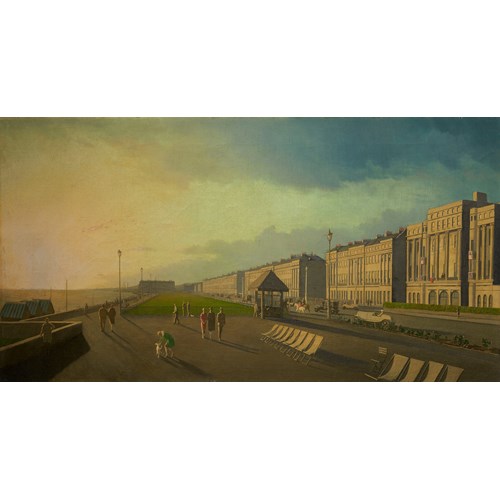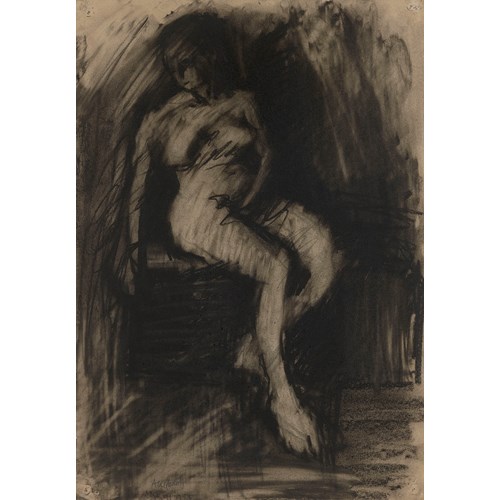Bartolomeo Cavaceppi
Apollino, after the Antique
Medium Marble
Dimension 71 cm (28⁰/₁ inches)
Copied from the celebrated Medici Apollo now in the Uffizi, this is a rare example of a signed marble by one of the most celebrated artistic figures active in Italy in the Settecento. Carved and polished to an exacting degree, this classically inspired reduced-size sculpture of Apollino would have been a highly coveted item for any Grand Tourist making their way through Italy in the eighteenth century. English collectors, having toured the great noble collections, and also having witnessed the marvels being pulled daily from the ground during their sojourn in Italy, were both eager to furnish their stately homes and keen to create replica galleries.
A new breed of businessman, Bartolomeo Cavaceppi (1716-1799) was not just a leading sculptor, but also a restorer, dealer, advisor and antiquarian in his own right. A shrewd entrepreneur, Cavaceppi had his own gallery and large studio which made him much in demand amongst Grand Tourists - whose collecting habits were defining the art market in Italy during that period. An increasing interest in the artworks of antiquity amongst British collectors in the eighteenth century was brought about by the discoveries being made in Italy and also through the increased dissemination of knowledge in that field amongst intellectuals of the day. For example, The Society of Dilettanti, founded in 1732 by a group of young Grand Tourists, was made up of aristocrats, scholars and artists and serves as a roll call of the most important collectors of the following one hundred years. The literary and social influence of such societies was complimented by the discovery of Herculaneum and Pompei in 1738 and 1748 respectively. Furthermore, the creation of the public museums of ancient art in Rome, such as the Museo Capitolino in 1734 and the Museo Pio-Clementino in 1771, helped stimulate further the interest in the Antique; as did the election of Pope Pius VI (1717-1799); whose long reign marked the golden years for excavation and trade in classical statuary.
Having initially been apprenticed under the French sculptor Pierre-Etienne Monnot (1657-1733) from 1729 to 1733, by 1732 Cavaceppi had become a prize-winning student at the Accademia di San Luca and remained in Rome, where he lived and worked for the rest of his life. In 1734 he became restorer to the most ambitious and learned private collector of antiquities in Rome, Cardinal Alessandro Albani (1692-1779). Through Albani, Cavaceppi gained many commissions from foreign visitors, particularly British Grand Tourists, who were busy setting up galleries at home, thus making his workshop on Via del Babuino one of the most eminent stops for visitors to Rome. In great demand among the major collectors and agents of central Europe and England his clients included such figures as Thomas William Coke, 1st Earl of Leicester; Charles Wyndham, 2nd Earl of Egremont; Matthew Brettingham; Gavin Hamilton; and Thomas Jenkins. Indeed, virtually every major collector of antiquities over the next half-century bought works from his studios, including Frederick William II of Prussia, Gustav III of Sweden, Catherine II of Russia, Cardinal José Nicolás de Azara, Charles Townley, William Weddell, Henry Blundell, Lyde Browne, Johann Joachim Winckelmann (another protégé of Albani, and a close friend of Cavaceppi), and Anton Raphael Mengs.
The antique prototype for Cavaceppi’s Apollino is a Roman copy after a Greek original, which was found in Rome in the 17th century. Known as Apollino or The Medici Apollo, it was originally held in the Borghese Collection, before entering the Medici family’s collection at the Villa Medici, where it was recorded in 1704. Today the statue is on display in the Uffizi Galleries, in Florence. The Medici Apollo was one of the most famous and copied antique statues of the eighteenth century, praised by the likes of Winckelmann, Richardson, and Mengs it was also lauded by the poet Percy Bysshe Shelley for its ‘flowing perfection’. Despite its widespread fame, Cavaceppi must have also known the sculpture personally, as it remained in his home city of Rome for most of his lifetime. Indeed, it was not moved to Florence until 1769-70, when it was transported by the Medici along with the equally famous Niobe Group. The Uffizi antiquity is approximately 141 cm high, exactly double the size of the present reduced-size marble. The Apollino depicts Apollo as an adolescent and is, in literature at least, associated with its counterpart, the Apollo Belvedere (Vatican Museum, Rome). Whilst the Belvedere statue represents the god as an adult, or the sun in full splendour of day; the Medici statue of the adolescent Apollino, can be associated with the notion of dawn.
Cavaceppi’s Apollino can be compared with a terracotta version (present whereabouts unknown), from the collection of Wentworth Woodhouse, home of The Hon. Charles Watson-Wentworth, 2nd Earl of Rockingham (1730-1782) which was sold at the sale of the house contents held in 1949, as lot 438. Rockingham, who also owned a life-size marble Apollino copy by Simon Vierpyl (1710-1825) still in-situ, was one of Cavaceppi’s earliest English patrons, having owned ‘The Wentworth Woodhouse Centaurs’ (York Museums) depicting a Young Centaur (tempted by love) and Old Centaur (bound by love), probably carved by Cavaceppi in Rome, and purchased by Rockingham in 1761. Despite this, the terracotta sold with the contents of the house, was not signed, nor attributed to Cavaceppi, and simply described in the auction catalogue as: An 18th-century terra cotta statuette “Nude Apollo”, a quiver of arrows by his side slung from a tree trunk 23ins.
Tantalizingly, an entry of March 1762 in Rockingham’s ledgers, show that the sculptor Joseph Wilton obtained 2 ‘small’ statues of Isis and Apollo for Rockingham from Lyde Browne (d. 1787, a banker, antiquarian and collector and an acquaintance of Cavaceppi in Rome). The entry lists payment: ‘To Mr Wilton for statues of Apollo and Isis from Mr Browne for £52-10-0 on March 12 1762’ (Wentworth Woodhouse Archives A100).
That the terracotta listed in the 1949 Spencer sale is not signed by Cavaceppi nor attributed to him suggest it likely to be by an English sculptor of the 18th century emulating the present marble Apollino by Cavaceppi at the behest of Rockingham. We know from his account book, that Matthew Brettingham (1725-1803) an English dealer, and sculptor and contemporary of Cavaceppi, is known to have bought, in 1752, a plaster cast of Cavaceppi’s Apollino or 'Gesso of ye Little Apollo' (see Kenworthy-Browne, op. cit, p. 68) which may be identified with the plaster cast now at Holkham. Another plaster copy of the Apollino by Brettingham is in the collection at Kedleston Hall, Derbyshire, dated to circa 1758, and measuring 143 cm high. It is likely that, between Cavaceppi’s autograph version, and Brettingham’s plaster casts, artists were able to make further copies of the celebrated Apollino for the increasing number of English patrons wanting to buy classical statuary and in particular, copies of Cavaceppi’s Apollino – as exemplified by John Cheere’s lead version at Stourhead.
A Note on the Provenance
Alfred Theodore Arber-Cooke (c.1905-1993) lived in Carmarthenshire, Wales, he was an avid collector of European and Asian works of art and also an author of ‘The History of Llandovery’. Arber-Cooke’s collecting spanned from the 1940s up until the late 1980s, purchasing the present work in 1946 from the London dealer Jacob Mendelson. Little known today, Mendelson, then based at 49 Berwick Street in Soho, was also the dealer who acquired many of the Cassiano del Pozzo ‘Paper Museum’ drawings when they were deaccessioned from the Royal Collection by Sir John Fortescue, helping to disperse them onto the art market in the 1950s. Mendelson may also be remembered for having been married to Lilian Holt between 1922 and 28. Together Jacob and Lilian had a daughter, Dinora Mendelson (1924-2010), an artist, whose stepfather was David Bomberg on account of Lilian’s marriage to him in 1929. Dinora herself married Bomberg’s pupil, and fellow artist, Sir Leslie Marr.
In 1985, Seymour Howard, a leading expert on Cavaceppi, informed Arber-Cooke that the present sculpture was previously unknown to him but as a signed autograph version was a ‘charming treasure’.
Representing the apotheosis of neoclassical sculpture, this is an extremely rare, signed work by the leading Roman sculptor of the eighteenth century, and an important addition to his known oeuvre. Without doubt the sheer virtuosity of the carving and precision of the finishing set this apart as a masterwork of neoclassical sculpture in this country and an important document of the demand amongst Grand Tourists for leading examples of classically inspired sculpture.
Medium: Marble
Signature: Signed ‘BARTOLOMEO CAVACEPPI’ to the back of the tree trunk
Dimension: 71 cm (28⁰/₁ inches)
Provenance: with Jacob Mendelson, Berwick Street, Soho, London, 1946
Alfred Theodore Arber-Cooke (c.1905-1993); acquired above and by descent, until 2021
Literature: B. Cavaceppi, Raccolta d'antiche statue busti bassirilievi ed altre sculture restaurate da Bartolomeo Cavaceppi scultore romano. Rome, 1768.
S. Howard, Bartolomeo Cavaceppi, eighteenth-century restorer, PHD Thesis, 1982.
J. Kenworthy-Browne. “Matthew Brettingham’s Rome Account Book 1747-1754”, published in The Walpole Society , 1983, Vol. 49, pp. 37-132.
C. Picon, Bartolomeo Cavaceppi: Eighteenth century restorations…exh. Cat. Clarendon Gallery, 1983, London.
Barberini et al, Bartolomeo Cavaceppi, scultore romano (1717-1799): Roma, Museo del Palazzo di Venezia, 25 gennaio-15 marzo 1994.
C. Gasparri, and O Ghiandoni, Lo studio Cavaceppi e le collezioni Torlonia
M. Vickers, “Bartolomeo Cavaceppi scultore romano (1717 1799)”, in Journal of the History of Collections, 1995.
More artworks from the Gallery




_T638354709335648178.jpg?width=500&height=500&mode=pad&scale=both&qlt=90&format=jpg)




